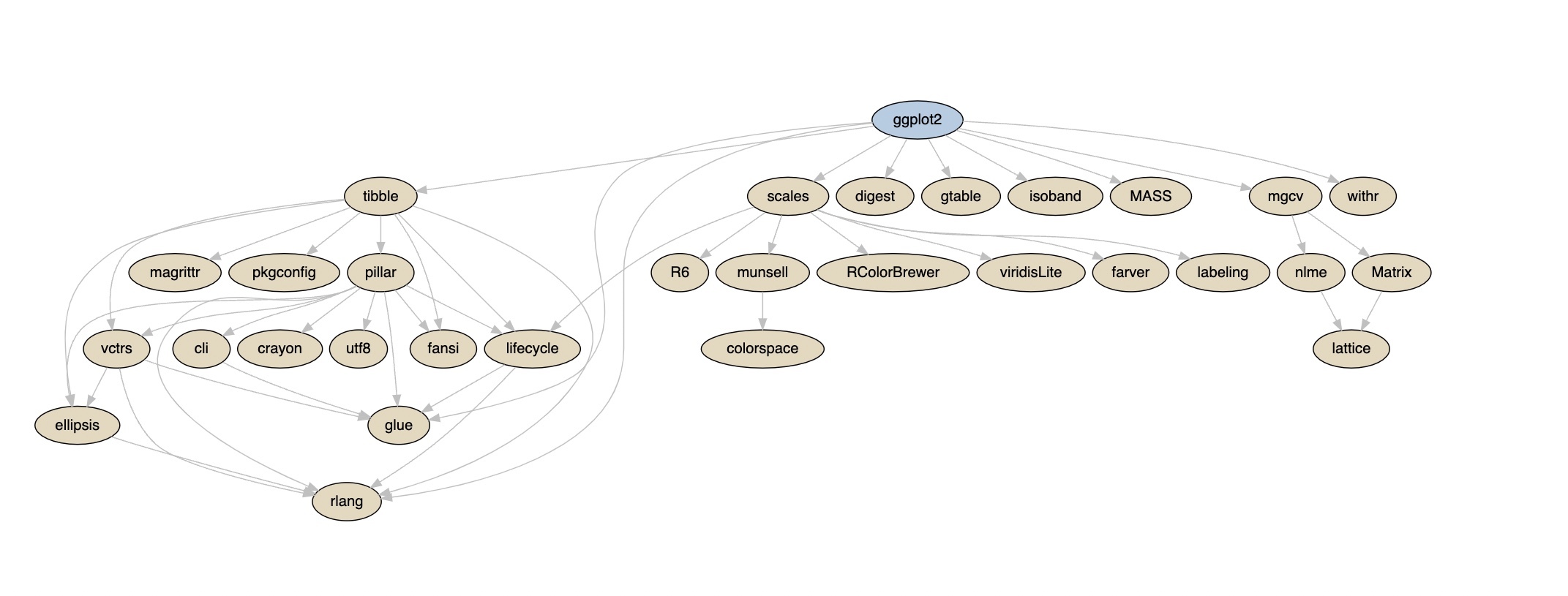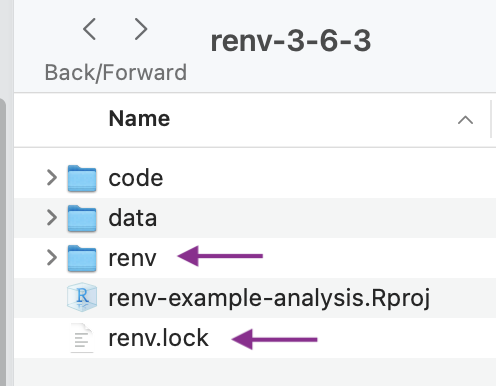Setting up isolated project-libraries using {renv}
Catherine Blatter
RRTM, 15.03.2022
renv} | RRTM, 15.03.2022 Have you ever...
renv} | RRTM, 15.03.2022 Have you ever...
- written code that produced beautiful output until suddenly it didn't?
renv} | RRTM, 15.03.2022 Have you ever...
- written code that produced beautiful output until suddenly it didn't?
- ran a statistical model that - out of the blue - throws a warning?
renv} | RRTM, 15.03.2022 Have you ever...
- written code that produced beautiful output until suddenly it didn't?
- ran a statistical model that - out of the blue - throws a warning?
- copied code from a colleague that just does not work on your computer?
renv} | RRTM, 15.03.2022 Have you ever...
- written code that produced beautiful output until suddenly it didn't?
- ran a statistical model that - out of the blue - throws a warning?
- copied code from a colleague that just does not work on your computer?
Time-consuming and frustrating issue (typically after updating)
renv} | RRTM, 15.03.2022 Have you ever...
- written code that produced beautiful output until suddenly it didn't?
- ran a statistical model that - out of the blue - throws a warning?
- copied code from a colleague that just does not work on your computer?
Time-consuming and frustrating issue (typically after updating)
- Popular solution: "If there is one thing I have learnt in R is to never ever update anything!"
quote from and with permission of Lauriane
Goals of today's research flash
Describe the internal setup and interrelations between R, RStudio, R packages and their versions
Goals of today's research flash
Describe the internal setup and interrelations between R, RStudio, R packages and their versions
Present a conceptual solution & technical framework designed to tackle the issue:
- Isolated project-libraries with {
renv}
renv} | RRTM, 15.03.2022 R, RStudio and R packages
renv} | RRTM, 15.03.2022 R, RStudio and R packages
renv} | RRTM, 15.03.2022 R, RStudio and R packages
Versions to report in a publication
renv} | RRTM, 15.03.2022 R, RStudio and R packages
renv} | RRTM, 15.03.2022 The R System library
renv} | RRTM, 15.03.2022 The R System library
- Directory1 where packages are stored2 and looked up3 for an analysis
renv} | RRTM, 15.03.2022 The R System library
- Directory1 where packages are stored2 and looked up3 for an analysis
1use .libPaths() to check where, 2stored = install.packages(), 3looked up = library()
renv} | RRTM, 15.03.2022 The R System library
- Directory1 where packages are stored2 and looked up3 for an analysis
1use .libPaths() to check where, 2stored = install.packages(), 3looked up = library()
- Installation/update of a package == removal of a previous version
e.g. update to {ggplot2} 3.3.5 == 2.3.9
renv} | RRTM, 15.03.2022 R package dependencies
renv} | RRTM, 15.03.2022 R package dependencies
- Packages can be linked to other packages (dependent): e.g. {
ggplot2} has got 30 dependencies:
Fig.source: RStudio, February 2022
renv} | RRTM, 15.03.2022 R package dependencies
- Packages can be linked to other packages (dependent): e.g. {
ggplot2} has got 30 dependencies:
Fig.source: RStudio, February 2022
- Installation/update of 1 package == updates all dependencies as well
renv} | RRTM, 15.03.2022 What does this mean for an analysis?
renv} | RRTM, 15.03.2022 What does this mean for an analysis?
Example
- Explicit use of 3 packages (by
library()):
library(ggplot2) # powerful plotting librarylibrary(lme4) # multi-level modellinglibrary(naniar) # dealing with missing valuesrenv} | RRTM, 15.03.2022 What does this mean for an analysis?
Example
- Explicit use of 3 packages (by
library()):
library(ggplot2) # powerful plotting librarylibrary(lme4) # multi-level modellinglibrary(naniar) # dealing with missing values- R implicitly uses 41 packages
renv} | RRTM, 15.03.2022 What does this mean for an analysis?
Example
- Explicit use of 3 packages (by
library()):
library(ggplot2) # powerful plotting librarylibrary(lme4) # multi-level modellinglibrary(naniar) # dealing with missing values- R implicitly uses 41 packages
Usual analysis
- Explicit use of 10-15 packages
renv} | RRTM, 15.03.2022 What does this mean for an analysis?
Example
- Explicit use of 3 packages (by
library()):
library(ggplot2) # powerful plotting librarylibrary(lme4) # multi-level modellinglibrary(naniar) # dealing with missing values- R implicitly uses 41 packages
Usual analysis
Explicit use of 10-15 packages
Implicit interrelations are difficult to gasp & impossible to track by hand
renv} | RRTM, 15.03.2022 What does this mean for an analysis?
Example
- Explicit use of 3 packages (by
library()):
library(ggplot2) # powerful plotting librarylibrary(lme4) # multi-level modellinglibrary(naniar) # dealing with missing values- R implicitly uses 41 packages
Usual analysis
Explicit use of 10-15 packages
Implicit interrelations are difficult to gasp & impossible to track by hand
Issue: (recommended) update unintended consequence
renv} | RRTM, 15.03.2022 The conceptual solution
renv} | RRTM, 15.03.2022 The conceptual solution
renv} | RRTM, 15.03.2022 The conceptual solution
Isolated project-libraries (also called environments)
renv} | RRTM, 15.03.2022 The conceptual solution
Isolated project-libraries (also called environments)
renv} | RRTM, 15.03.2022 Isolated libraries (environments)
renv} | RRTM, 15.03.2022 Isolated libraries (environments)
- Standard practice in programming languages, e.g. Python
further info: https://environments.rstudio.com/, https://peps.python.org/pep-0405/
renv} | RRTM, 15.03.2022 Isolated libraries (environments)
- Standard practice in programming languages, e.g. Python
further info: https://environments.rstudio.com/, https://peps.python.org/pep-0405/
- ...one of the main reasons that non-programmers do not proceed with Python
renv} | RRTM, 15.03.2022 Isolated libraries (environments)
- Standard practice in programming languages, e.g. Python
further info: https://environments.rstudio.com/, https://peps.python.org/pep-0405/
- ...one of the main reasons that non-programmers do not proceed with Python
Fundamentally different to 'usual' interaction with a computer:
- Imagine the need to define how to use MS Word before creating a new Word-document
renv} | RRTM, 15.03.2022 Isolated libraries (environments)
- Standard practice in programming languages, e.g. Python
further info: https://environments.rstudio.com/, https://peps.python.org/pep-0405/
- ...one of the main reasons that non-programmers do not proceed with Python
Fundamentally different to 'usual' interaction with a computer:
- Imagine the need to define how to use MS Word before creating a new Word-document
- R user = academic researcher, often without any formal training in programming -
lack of knowledge on situation and solution
renv} | RRTM, 15.03.2022 The technical framework: {renv}
renv} | RRTM, 15.03.2022 The technical framework: {renv}
- R package designed to create reproducible environments
by initiating isolated project-libraries
Kevin Ushey (2022). renv: Project Environments. R package version 0.15.2.
renv} | RRTM, 15.03.2022 The technical framework: {renv}
- R package designed to create reproducible environments
by initiating isolated project-libraries
Kevin Ushey (2022). renv: Project Environments. R package version 0.15.2.

What do I see when using {
renv}?a subfolder
renvthat contains the isolated library
(useful on your computer)a lockfile
renv.lockwhere all versions are documented
(useful for creating the same library on another computer)
renv} | RRTM, 15.03.2022 Reflection & key points
renv} | RRTM, 15.03.2022 Reflection & key points
- {
renv} is not a uniform solution to computational reproducibility
renv} | RRTM, 15.03.2022 Reflection & key points
{
renv} is not a uniform solution to computational reproducibilityAlternatives are available - require more technical know-how
renv} | RRTM, 15.03.2022 Reflection & key points
{
renv} is not a uniform solution to computational reproducibilityAlternatives are available - require more technical know-how
{
renv} offers a lightweight & manageable solution tosetup and use multiple libraries across your computer
easily document all versions and dependencies of packages
share your environment-setup with other collaborators
Setup {renv}
Official documentation: https://rstudio.github.io/renv/articles/renv.html
1) Open the .Rproj-file of the desired analysis-folder
2) Call install.packages("renv")
3) Call renv::init()
this creates the subfolder and the
renv.lock-file{
renv} interacts with you in the console & prints what it does
4) Continue working as usual - if you need to install further packages, they are installed in the project-library
5) From time to time: call renv::snapshot()
adds all the packages used in this project to the
renv.lock-file
Setup tested with {renv} 0.15.2, R Version 4.1.3 on Mac OS X 12.2.1
Alternatives
- https://annotater.liomys.mx/ - annotates the version or R packages used in a script (downside: no dependencies, manual installation)
- https://github.com/MilesMcBain/capsule - mimics the lockfile, not the isolated library (downside: need to set-up the environment every time you work on the analysis)
- Setting up everything by hand with {
base}-R